List of counties in Michigan
There are 83 counties in the U.S. state of Michigan. The boundaries of these counties have not changed substantially since 1897. However, throughout the 19th century, the state legislature frequently adjusted county boundaries. County creation was intended to fulfill the goal of establishing government over unorganized territory, but a more important goal was encouraging settlement by surveying the land and dividing it into saleable sections.
| Counties of Michigan | |
|---|---|
| Location | Michigan |
| Number | 83 |
| Populations | 2,180 (Keweenaw) – 1,757,043 (Wayne) |
| Areas | 508 square miles (1,320 km2) (Cass) – 5,966 square miles (15,450 km2) (Keweenaw) |
| Government | |
| Subdivisions | |
The creation of counties generally occurred in two stages. First the boundaries of a county were declared and given a name. The county appeared on maps, even though this may have been the entire extent of a county's tangible existence for several years. During this period, the as-yet–unorganized county was attached to another already organized county for administrative purposes. The legislature frequently changed the administrative attachment of these unorganized counties. Residents of such an attached county could petition the legislature for organization, which was the granting of full legal recognition to the county.
There are many cities and villages that span county boundaries in Michigan, including its capital, Lansing. For a few years during the early 1970s, split cities briefly had authority to petition to change the county boundaries to accord with the city boundaries. The only city to take advantage of this brief opportunity was New Baltimore (previously split between Macomb County and St. Clair County; now completely in Macomb). This transfer of territory from St. Clair to Macomb was the only county boundary change in Michigan since the early 20th century.
The state constitution of 1850 permitted an incorporated city with a population of at least 20,000 to be organized into a separate county of its own.[1] The Constitution of 1908 retained this provision, but raised the population threshold to 100,000.[2] No city was ever organized into an independent county in this fashion and when a new Constitution took effect in 1963, the provision was removed.
Michigan's boundary with Illinois is formed by Lake Michigan, and three counties have water boundaries with Illinois: Berrien County, Van Buren County, and Allegan County. Michigan also has a boundary with Minnesota, which is formed by Lake Superior. The water boundary in this instance is formed by two counties: Ontonagon County and Keweenaw County. The land boundary with Wisconsin continues into Lake Superior, involving both Gogebic County (which shares a land border) and Ontonagon County (water boundary only).
Etymologies
Nine counties have names invented by the ethnologist Henry Schoolcraft, usually adapted from parts of Native American words, but sometimes having parts from Greek, Arabic and Latin roots.[3] Schoolcraft's made-up words have disputed sources. While he was a devotee of Native American words and culture, some of his words may have originated with tribes from other areas of the country, such as New York or the Northeast, where many settlers to Michigan came from. Real Native words were eradicated, and he substituted made-up words, sometimes with a kernel of Indian language or sound in them.[4][5][6]
A second group of four counties were renamed for Irish locales (counties Antrim, Clare, Roscommon and Wexford), apparently because it was close to the heart for certain Michigan legislators or their constituents.
Ten counties, the so-called "cabinet counties", were named for persons who served in Andrew Jackson's presidential administration, which was tied to Michigan's anticipated ascendancy to statehood. Eight were named in 1829. Livingston County was named in 1833. Cass County was also named in 1829, but Governor Lewis Cass did not become a member of Jackson's Cabinet until 1831.[3][4][7]
List of counties
| County |
FIPS Code[8] | County seat |
Est. |
Origin |
Etymology |
Population |
Area |
Map |
|---|---|---|---|---|---|---|---|---|
| Alcona County | 001 | Harrisville | 1840 (boundaries declared) 1869 (organized) | From unorganized territory; named Negwegon County until 1843 | Schoolcraft pseudo-Native American name | 10,417 | 1,791 sq mi (4,639 km2) |  |
| Alger County | 003 | Munising | 1885 | From part of Schoolcraft County | Russell A. Alger, (1836-1907): Governor and national politician |
8,807 | 5,049 sq mi (13,077 km2) |  |
| Allegan County | 005 | Allegan | 1831 (boundaries declared) 1835 (organized) | From part of Barry County, and unorganized territory | Schoolcraft pseudo-Native American name | 121,210 | 1,833 sq mi (4,747 km2) |  |
| Alpena County | 007 | Alpena | 1840 (boundaries declared) 1857 (organized) | From part of Mackinac County, and unorganized territory Was named Anamickee County until 1843. | Schoolcraft pseudo-Native American name | 28,847 | 1,695 sq mi (4,390 km2) |  |
| Antrim County | 009 | Bellaire | 1840 (boundaries declared) 1863 (organized) | From part of Mackinac County; named Meegisee County until 1843 | County Antrim, now in Northern Ireland | 24,249 | 602 sq mi (1,559 km2) |  |
| Arenac County | 011 | Standish | 1831 (boundaries established) 1883 (organized) | From unorganized territory; annexed to Bay County in 1857, but reinstated in 1883 | Schoolcraft pseudo-Native American name | 15,089 | 681 sq mi (1,764 km2) |  |
| Baraga County | 013 | L'Anse | 1875 | From part of Houghton County | Frederic Baraga (1797-1868): Catholic missionary and first bishop of Sault Ste. Marie | 8,277 | 1,069 sq mi (2,769 km2) |  |
| Barry County | 015 | Hastings | 1829 (boundaries established) 1839 (organized) | From unorganized territory | William T. Barry (1784-1835): Postmaster General in the Jackson Administration | 63,554 | 577 sq mi (1,494 km2) |  |
| Bay County | 017 | Bay City | 1857 | From parts of Arenac, Midland, and Saginaw Counties | Saginaw Bay | 102,821 | 631 sq mi (1,634 km2) | 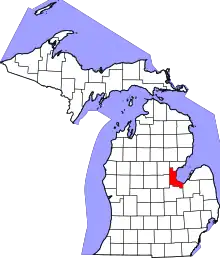 |
| Benzie County | 019 | Beulah | 1863 | From part of Leelanau County | French name of Betsie River: (rivière aux) Bec-scies, the "(river of) sawbill ducks" | 18,297 | 860 sq mi (2,227 km2) | 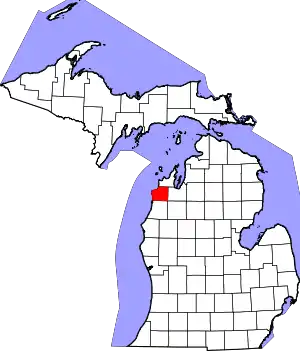 |
| Berrien County | 021 | St. Joseph | 1829 | From unorganized territory | John M. Berrien (1781-1856): Attorney General in the Jackson Administration | 152,900 | 1,581 sq mi (4,095 km2) |  |
| Branch County | 023 | Coldwater | 1829 | From unorganized territory | John Branch (1782-1863): Secretary of the Navy in the Jackson Administration | 44,531 | 519 sq mi (1,344 km2) |  |
| Calhoun County | 025 | Marshall | 1829 | From unorganized territory | John C. Calhoun (1782-1850): Vice President of the United States in the Jackson Administration | 133,289 | 718 sq mi (1,860 km2) |  |
| Cass County | 027 | Cassopolis | 1829 | From unorganized territory | Lewis Cass (1782-1866): Secretary of War in the Jackson Administration | 51,403 | 508 sq mi (1,316 km2) |  |
| Charlevoix County | 029 | Charlevoix | 1869 | From parts of Antrim, Emmet, and Otsego Counties | Pierre François Xavier de Charlevoix (1682-1761): Jesuit traveller and historian of New France | 26,293 | 1,391 sq mi (3,603 km2) |  |
| Cheboygan County | 031 | Cheboygan | 1840 | From part of Mackinac County | Cheboygan River | 25,940 | 885 sq mi (2,292 km2) |  |
| Chippewa County | 033 | Sault Ste. Marie | 1827 | From part of Mackinac County | Ojibwa Native American tribe, also known as the Chippewa | 36,293 | 2,698 sq mi (6,988 km2) |  |
| Clare County | 035 | Harrison | 1840 | From part of Mackinac County, and unorganized territory; named Kaykakee County until 1843 | County Clare, Ireland | 31,352 | 575 sq mi (1,489 km2) |  |
| Clinton County | 037 | St. Johns | 1831 | From unorganized territory | DeWitt Clinton (1769-1828): Governor of New York. | 79,748 | 575 sq mi (1,489 km2) |  |
| Crawford County | 039 | Grayling | 1840 | From part of Mackinac County and unorganized territory. Was named Shawano County until 1843. | William Crawford, (1732-82), American Revolutionary War colonel western surveyor | 13,491 | 563 sq mi (1,458 km2) |  |
| Delta County | 041 | Escanaba | 1843 | From part of Mackinac County and unorganized territory. | Greek letter delta, referring to the triangular shape of the original county, which included segments of Menominee, Dickinson, Iron and Marquette counties | 36,741 | 1,992 sq mi (5,159 km2) |  |
| Dickinson County | 043 | Iron Mountain | 1891 | From parts of Iron County, Marquette County and Menominee County. | Donald M. Dickinson (1846-1917): Postmaster General in the Cleveland Administration | 25,874 | 777 sq mi (2,012 km2) |  |
| Eaton County | 045 | Charlotte | 1829 | From unorganized territory. | John Eaton (1790-1856): Secretary of War in the Jackson Administration | 108,992 | 579 sq mi (1,500 km2) |  |
| Emmet County | 047 | Petoskey | 1840 | From part of Mackinac County. Was named Tonegadana County until 1843. | Robert Emmet (1778-1803): Irish nationalist and rebel leader | 34,163 | 882 sq mi (2,284 km2) |  |
| Genesee County | 049 | Flint | 1835 | From parts of Lapeer County, Saginaw County and Shiawassee County. | Seneca word, "je-nis-hi-yeh," meaning "beautiful valley": named after western New York valley from which many settlers came | 401,983 | 649 sq mi (1,681 km2) |  |
| Gladwin County | 051 | Gladwin | 1831 | From unorganized territory. | Major Henry Gladwin, British commander of the fort at Detroit during the siege by Chief Pontiac in 1763-64. | 25,728 | 516 sq mi (1,336 km2) |  |
| Gogebic County | 053 | Bessemer | 1887 | From part of Ontonagon County. | Probably from the Chippewa "bic" which most references interpret as "rock." | 14,319 | 1,476 sq mi (3,823 km2) |  |
| Grand Traverse County | 055 | Traverse City | 1840 (boundaries declared) 1851 (organized) | From part of Mackinac County; named Omeena County until 1851. | French grande traverse[note 1] ("long crossing"), given first to Grand Traverse Bay by French voyageurs. | 96,464 | 601 sq mi (1,557 km2) |  |
| Gratiot County | 057 | Ithaca | 1831 | From unorganized territory. | Captain Charles Gratiot (1788-1855), built Fort Gratiot at the present site of Port Huron | 41,100 | 572 sq mi (1,481 km2) |  |
| Hillsdale County | 059 | Hillsdale | 1829 | From unorganized territory. | From its terrain, made up of hills and dales.[10] | 45,762 | 607 sq mi (1,572 km2) |  |
| Houghton County | 061 | Houghton | 1845 | From parts of Marquette County and Ontonagon County. | Douglass Houghton (1809-1845), first state geologist of Michigan, physician and surgeon, mayor of Detroit (1842-1843) | 37,035 | 1,502 sq mi (3,890 km2) |  |
| Huron County | 063 | Bad Axe | 1840 | From part of Sanilac County. | Lake Huron, which the French named lac des Hurons after the Hurons. | 31,248 | 2,136 sq mi (5,532 km2) |  |
| Ingham County | 065 | Mason | 1829 (boundaries declared) 1838 (organized) | From parts of Shiawassee County, Washtenaw County and unorganized territory. | Samuel D. Ingham (1779-1860), U.S. Secretary of the Treasury in the Jackson Administration | 284,108 | 561 sq mi (1,453 km2) |  |
| Ionia County | 067 | Ionia | 1831 | From part of Mackinac County and unorganized territory. | Province in ancient Greece | 66,809 | 580 sq mi (1,502 km2) |  |
| Iosco County | 069 | Tawas City | 1840 | From unorganized territory. Was named Kanotin County until 1843. | Schoolcraft pseudo-Native American name | 25,521 | 1,891 sq mi (4,898 km2) |  |
| Iron County | 071 | Crystal Falls | 1885 | From parts of Marquette County and Menominee County. | For the iron deposits and mines found in the county | 11,622 | 1,211 sq mi (3,136 km2) | 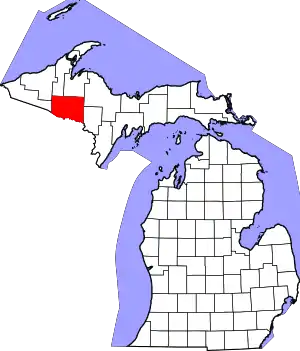 |
| Isabella County | 073 | Mt. Pleasant | 1831 | From part of Mackinac County and unorganized territory. | Queen Isabella I (1451-1504) of Spain, under whose patronage Columbus undertook his voyages. | 64,447 | 578 sq mi (1,497 km2) |  |
| Jackson County | 075 | Jackson | 1829 (boundaries declared) 1832 (organised) | From part of Washtenaw County and unorganized territory. | Andrew Jackson (1767-1845), 7th President of the United States and President when Michigan was admitted to the Union | 160,066 | 724 sq mi (1,875 km2) | 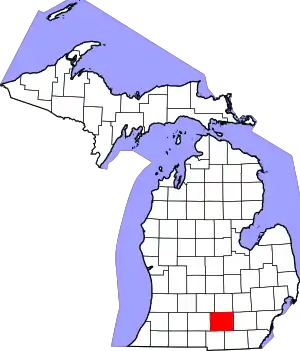 |
| Kalamazoo County | 077 | Kalamazoo | 1829 | From unorganized territory. | Named for the Kalamazoo River. See Etymology of Kalamazoo for a discussion of the river's name. | 261,173 | 580 sq mi (1,502 km2) |  |
| Kalkaska County | 079 | Kalkaska | 1840 | From part of Mackinac County. Was named Wabassee County until 1843. | Schoolcraft pseudo-Native American name | 18,182 | 571 sq mi (1,479 km2) |  |
| Kent County | 081 | Grand Rapids | 1831 | From part of Mackinac County and unorganized territory. | New York jurist James Kent, who represented the Michigan Territory in its dispute with Ohio over the Toledo Strip. | 659,083 | 872 sq mi (2,258 km2) |  |
| Keweenaw County | 083 | Eagle River | 1861 | From part of Houghton County. | Ojibwe word gakiiwe-wewaning meaning "portage" | 2,180 | 5,966 sq mi (15,452 km2) |  |
| Lake County | 085 | Baldwin | 1840 | From part of Mackinac County. Was named Aischum County until 1843. | Has several small lakes and lies near Lake Michigan | 12,594 | 575 sq mi (1,489 km2) |  |
| Lapeer County | 087 | Lapeer | 1822 | From parts of Oakland County and St. Clair County. | An Americanization of the French la pierre, meaning "the rock" (flint) | 88,780 | 663 sq mi (1,717 km2) |  |
| Leelanau County | 089 | Suttons Bay Township | 1840 | From part of Mackinac County. | Schoolcraft pseudo-Native American name | 22,870 | 2,532 sq mi (6,558 km2) |  |
| Lenawee County | 091 | Adrian | 1822 | From part of Monroe County. | A Schoolcraft pseudo-Native American name for man, from either the Delaware leno or lenno or the Shawnee lenawai | 98,567 | 761 sq mi (1,971 km2) |  |
| Livingston County | 093 | Howell | 1833 (boundaries declared) 1836 (organized) | From parts of Shiawassee County and Washtenaw County. | Edward Livingston (1764-1836): second Secretary of State in the Andrew Jackson administration | 196,161 | 585 sq mi (1,515 km2) |  |
| Luce County | 095 | Newberry | 1887 | From parts of Chippewa County and Mackinac County. | Named for Michigan Governor Cyrus G. Luce | 5,330 | 1,912 sq mi (4,952 km2) |  |
| Mackinac County | 097 | St. Ignace | 1818 | From part of Wayne County. Was named Michilimackinac County until 1837. | Originally Michilimackinac, believed to be a French interpretation of the Native American name for Mackinac Island, meaning "big turtle" | 10,941 | 2,101 sq mi (5,442 km2) |  |
| Macomb County | 099 | Mt. Clemens | 1818 | From part of Wayne County. | Named for U.S. General Alexander Macomb, a notable officer of the War of 1812 | 874,195 | 570 sq mi (1,476 km2) |  |
| Manistee County | 101 | Manistee | 1840 | From part of Mackinac County. | Named for the Manistee River, which in turn is from the Ojibwe name, ministigweyaa meaning "(river) at whose mouth there are islands" | 25,287 | 1,281 sq mi (3,318 km2) | 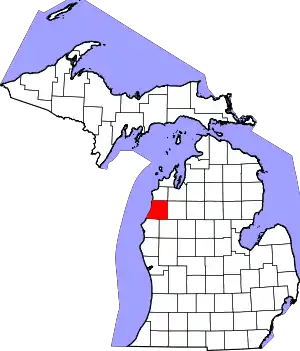 |
| Marquette County | 103 | Marquette | 1843 | From parts of Chippewa County and Mackinac County. | Named for French Jesuit missionary Jacques Marquette | 66,661 | 3,425 sq mi (8,871 km2) |  |
| Mason County | 105 | Ludington | 1840 | From part of Mackinac County. Was named Notipekago County until 1843. | Named for Michigan Governor Stevens T. Mason | 29,409 | 1,242 sq mi (3,217 km2) |  |
| Mecosta County | 107 | Big Rapids | 1840 | From parts of Mackinac County and Oceana County. | Named for Mecosta, a Native American leader | 40,720 | 571 sq mi (1,479 km2) |  |
| Menominee County | 109 | Menominee | 1861 | From part of Delta County. Was named Bleeker County until 1863. | Named for the Menominee Native American people | 23,266 | 1,338 sq mi (3,465 km2) |  |
| Midland County | 111 | Midland | 1831 | From part of Saginaw County and unorganized territory. | Located near the geographical center of the Lower Peninsula | 83,674 | 528 sq mi (1,368 km2) |  |
| Missaukee County | 113 | Lake City | 1840 | From part of Mackinac County. | Named for Missaukee, an Ottawa leader who signed land-grant treaties in 1831 and 1833 | 15,213 | 574 sq mi (1,487 km2) |  |
| Monroe County | 115 | Monroe | 1817 | From part of Wayne County. | Named for James Monroe, the fifth U.S. President | 155,609 | 680 sq mi (1,761 km2) |  |
| Montcalm County | 117 | Stanton | 1831 | From part of Mackinac County and unorganized territory. | Named for Louis-Joseph de Montcalm, a French military commander in Quebec | 67,433 | 721 sq mi (1,867 km2) |  |
| Montmorency County | 119 | Atlanta | 1840 | From part of Mackinac County and unorganized territory. Was named Cheonoquet County until 1843. | House of Montmorency, influential in the history of French Canada | 9,569 | 562 sq mi (1,456 km2) |  |
| Muskegon County | 121 | Muskegon | 1859 | From parts of Oceana County and Ottawa County. | Muskegon River running through county, from the Ojibwa/Chippewa word mashkig meaning "swamp" or "marsh." | 176,565 | 1,459 sq mi (3,779 km2) | 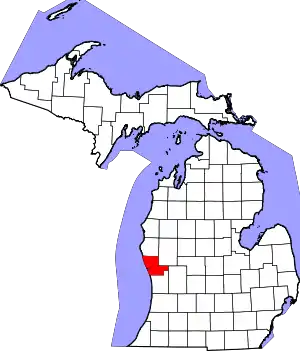 |
| Newaygo County | 123 | White Cloud | 1840 | From parts of Mackinac County and Oceana County. | Named for a Chippewa leader who signed the Saginaw Treaty of 1819[11] | 50,886 | 861 sq mi (2,230 km2) |  |
| Oakland County | 125 | Pontiac | 1819 (boundaries declared) 1820 (organized) | From part of Macomb County. | The numerous "oak openings" in the area: "majestic orchard[s] of oaks and hickories varied by small prairies, grassy lawns and clear lakes"[12] | 1,269,431 | 908 sq mi (2,352 km2) |  |
| Oceana County | 127 | Hart | 1831 | From part of Mackinac County. | Borders Lake Michigan, the freshwater "ocean." | 26,973 | 1,307 sq mi (3,385 km2) |  |
| Ogemaw County | 129 | West Branch | 1840 | From unorganized territory. Annexed to Iosco County in 1867 and reinstated in 1873. | The Ojibwe word ogimaa, meaning "chief" or "leader" | 20,970 | 575 sq mi (1,489 km2) |  |
| Ontonagon County | 131 | Ontonagon | 1843 (boundaries declared) 1848 (organized) | From parts of Chippewa County and Mackinac County. | Named for the Ontonagon River. The Ojibwa word onagon means "dish" or "bowl." | 5,863 | 3,741 sq mi (9,689 km2) |  |
| Osceola County | 133 | Reed City | 1840 | From part of Mackinac County. Was named Unwattin County until 1843. | Osceola (1804-1838), Seminole chief | 23,274 | 573 sq mi (1,484 km2) | 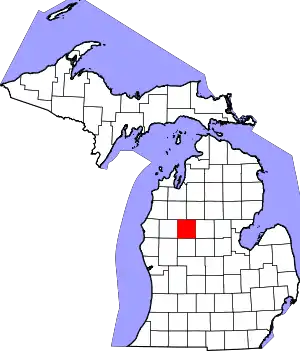 |
| Oscoda County | 135 | Mio | 1840 | From part of Mackinac County and unorganized territory. | Schoolcraft pseudo-Native American name | 8,404 | 572 sq mi (1,481 km2) |  |
| Otsego County | 137 | Gaylord | 1840 | From part of Mackinac County. Was named Okkudo County until 1843. | Named for Otsego County, New York | 25,644 | 526 sq mi (1,362 km2) |  |
| Ottawa County | 139 | Grand Haven | 1831 | From part of Mackinac County and unorganized territory. | Named for the Native American Ottawa people. | 300,873 | 1,632 sq mi (4,227 km2) |  |
| Presque Isle County | 141 | Rogers City | 1840 | From part of Mackinac County. | A derivation of the French phrase for "peninsula", literally "almost an island." | 13,361 | 2,573 sq mi (6,664 km2) |  |
| Roscommon County | 143 | Roscommon | 1840 | From part of Mackinac County and unorganized territory. Was named Mikenauk County until 1843. | County Roscommon, Ireland | 23,708 | 580 sq mi (1,502 km2) |  |
| Saginaw County | 145 | Saginaw | 1822 | From part of Oakland County. | A Native American term, perhaps a reference to the Saginaw River and Saginaw Bay, Ojibwe for "at the outlet" [13] | 188,330 | 816 sq mi (2,113 km2) |  |
| St. Clair County | 147 | Port Huron | 1820 | From part of Macomb County. | Named for either Arthur St. Clair, first governor of the Northwest Territory, or Saint Clair on whose feast day Lake St. Clair was discovered | 160,151 | 837 sq mi (2,168 km2) |  |
| St. Joseph County | 149 | Centreville | 1829 | From unorganized territory. | The St. Joseph River, which flows through the county.[14] | 60,874 | 521 sq mi (1,349 km2) |  |
| Sanilac County | 151 | Sandusky | 1822 | From part of St. Clair County. | Sanilac, a Wyandotte chief | 40,657 | 1,590 sq mi (4,118 km2) |  |
| Schoolcraft County | 153 | Manistique | 1843 | From parts of Chippewa County and Mackinac County. | Henry Rowe Schoolcraft, (1793-1864): American geographer and Superintendent of Indian Affairs in Michigan |
8,188 | 1,884 sq mi (4,880 km2) |  |
| Shiawassee County | 155 | Corunna | 1822 | From parts of Oakland County and St. Clair County. | Named for the Shiawassee River, and means 'river that twists about.[15] | 68,022 | 541 sq mi (1,401 km2) |  |
| Tuscola County | 157 | Caro | 1840 | From part of Sanilac County. | Schoolcraft pseudo-Native American name | 52,945 | 914 sq mi (2,367 km2) |  |
| Van Buren County | 159 | Paw Paw | 1829 | From unorganized territory. | Martin Van Buren (1782-1862): Secretary of State in the Jackson Administration, later Vice President and eighth President of the United States | 75,692 | 1,090 sq mi (2,823 km2) |  |
| Washtenaw County | 161 | Ann Arbor | 1822 (boundaries declared) 1826 (organised) | From parts of Oakland County and Wayne County | From the Native American name for the Grand River, O-wash-ta-nong ("faraway water"),[16] whose headwaters were within the county's bounds. | 366,376 | 723 sq mi (1,873 km2) |  |
| Wayne County | 163 | Detroit | 1815 | All lands within Michigan Territory that had been ceded by Native Americans through the 1807 Treaty of Detroit. | "Mad" Anthony Wayne, (1745-1796): United States Army general and statesman |
1,757,043 | 672 sq mi (1,740 km2) |  |
| Wexford County | 165 | Cadillac | 1840 | From part of Mackinac County. Was named Kautawaubet County until 1843. | County Wexford, Ireland | 34,196 | 576 sq mi (1,492 km2) |  |
Defunct counties and county precursors
This listing includes only counties or county precursors created by the Territory of Michigan or the State of Michigan. It excludes counties that existed in the Territory of Michigan or the modern boundaries of the State of Michigan but were created by any other entity (another state, a territorial government, the federal government, etc.) before the creation of the Territory of Michigan.[17]
- Brown County, formed on December 3, 1818, from unorganized territory when Michigan Territory was expanded to include area west of Lake Michigan upon formation of the state of Illinois. Transferred to Wisconsin Territory on July 3, 1836, and continues as Brown County, Wisconsin.
- Crawford County, formed on December 3, 1818, from unorganized territory when Michigan Territory was expanded to include area west of Lake Michigan upon formation of the state of Illinois. Transferred to Wisconsin Territory on July 3, 1836, and continues as Crawford County, Wisconsin.
- Des Moines County, formed on October 1, 1834, from unorganized territory. Transferred to Wisconsin Territory on July 3, 1836, and continues as Des Moines County, Iowa.
- Detroit District, formed on July 3, 1805, as a county precursor by Territorial Governor Lewis Cass to carry out the Territory's judicial and administrative functions. Superseded by counties on October 2, 1818, as proclaimed by William Woodbridge, Secretary of Michigan Territory.
- Dubuque County, formed on October 1, 1834, from unorganized territory. Transferred to Wisconsin Territory on July 3, 1836, and continues as Dubuque County, Iowa.
- Erie District, formed on July 3, 1805, as a county precursor by Territorial Governor William Hull to carry out the Territory's judicial and administrative functions. Included parts of modern-day Indiana and the Toledo Strip. Although the Erie District was officially superseded by counties by proclamation of Michigan Territorial Secretary William Woodbridge on October 2, 1818, the area of the district had actually been lost to the State of Indiana when it was created on December 11, 1816.
- Huron District formed on July 3, 1805, as a county precursor by Territorial Governor William Hull to carry out the Territory's judicial and administrative functions. Superseded by counties on October 2, 1818, as proclaimed by William Woodbridge, Secretary of Michigan Territory.
- Iowa County, formed on January 1, 1830, from part of Crawford County. Transferred to Wisconsin Territory on July 3, 1836, and continues as Iowa County, Wisconsin.
- Isle Royale County, formed on March 4, 1875, from part of Keweenaw County. County became officially unorganized on March 13, 1885, and was attached to Houghton County, for judicial and administrative purposes. Michigan Legislature officially dissolves Isle Royale County and returns it to Keweenaw County on April 9, 1897.
- Keskkauko County, formed on April 1, 1840, from part of Mackinac County. Renamed Charlevoix County, on March 8, 1843. Annexed to Emmet County, on January 29, 1853, and eliminated as a county. Reformed as Charlevoix County from Emmet, Antrim, and Otsego, Counties on April 2, 1869, albeit with boundaries that differed somewhat from the 1840–1853 iteration of Keskkauko–Charlevoix County.
- Manitou County, formed on February 12, 1855, from parts of Emmet County and Leelanau County. On March 16, 1861, Manitou County was attached to Mackinac County for meetings of the District Court, but all other County functions were unchanged. Four years later, on March 10, 1865, the District Court attachment was changed to Leelanau County instead of Mackinac. Another four years later, on March 24, 1869, the District Court attachment to Leelanau County was terminated. The entire Manitou County government was dissolved on April 4, 1895, and the county was abolished. It was absorbed by Charlevoix County, and Leelanau County.
- Michilimackinac District formed on July 3, 1805, as a county precursor by Territorial Governor William Hull to carry out the Territory's judicial and administrative functions. Incorporated into Wayne County, on October 18, 1816.
- Milwaukee County, formed on September 6, 1834, from part of Brown County. Transferred to Wisconsin Territory on July 3, 1836, and continues as Milwaukee County, Wisconsin.
- Omeena County, formed on April 1, 1840, from part of Mackinac County. Annexed to Grand Traverse County, on February 3, 1853.
- Wyandot County, formed on April 1, 1840, from part of Mackinac County. Annexed to Cheboygan County, on January 29, 1853.
- Washington County, formed in 1867 from Marquette County, but declared unconstitutional.
See also
References
- Constitution of the State of Michigan, 1850, Article 10, Section 2
- Constitution of the State of Michigan, 1908, Article 8, Section 2
- Clarke Historical Library, Central Michigan University, Bibliography by county and region, including origin of county names
- Romig, Walter; Massie, Larry B (Designer) (1986). Michigan Place Names: The History of the Founding and the Naming of More Than Five Thousand Past and Present Michigan Communities. Detroit, Michigan: Wayne State University Press. ISBN 978-0-8143-1838-6.
- Vogel, Virgil J. (1986). Indian Names in Michigan. Ann Arbor, Michigan: University of Michigan Press. pp. 244, 8 B&W photographs & 3 maps. ISBN 978-0-472-06365-9.
- Powers, Perry F.; Cutler, H.G., assisting (1912). A History of Northern Michigan and its People.
{{cite book}}: CS1 maint: multiple names: authors list (link) at Google books - "Michigan Counties" Archived July 28, 2009, at the Wayback Machine from the Michigan Department of History, Arts and Libraries, which contains additional references at the end of the article
- "EPA County FIPS Code Listing". EPA. Archived from the original on May 24, 2010. Retrieved September 8, 2008.
- Centre national de ressources textuelles
- Dan Bisher (1999). "A Brief History of 'Hillsdale County'". Archived from the original on June 7, 2008. Retrieved November 24, 2008.
- "Clarke Historical Library bibliographic entry for Newaygo County". Archived from the original on June 5, 2010. Retrieved September 14, 2009.
- As described by Bela Hubbard, surveyor of Michigan
- "Clarke Historical Library bibliographic entry for Saginaw County". Archived from the original on June 5, 2010. Retrieved September 14, 2009.
- John Marvin. "Background History on St. Joseph County". Archived from the original on June 15, 2008. Retrieved November 24, 2008.
- "Clarke Historical Library bibliographic entry for Shiawassee County". Archived from the original on June 5, 2010. Retrieved September 14, 2009.
- Publications of the Historical Society of Grand Rapids. 1906. p. 36.
- Michigan: Individual County Chronologies, John H. Long, Editor, 2007, The Newberry Library, accessed February 21, 2021 Archived May 15, 2018, at the Wayback Machine
- In modern standard French, la grande traversée; as the sense of 'crossing' is obsolete for traverse.[9]
Further reading
- Armitage, B. Phyllis. (October–December 1943). "A Study of Michigan's Place-Names". Michigan History magazine. 27: 626–637.
- County histories published in Michigan History Magazine. Some back issues that include these histories are still available for purchase.
- Jenks, William L. (1912). "History and Meaning of the County Names of Michigan". Collections and Researches of the Michigan Pioneer and Historical Society. 38: 439–478.
- Michigan Manual (the "Red Book") published biennially by the Legislative Service Bureau under the direction of the. Legislative Council, State of Michigan.
- Powers, Perry F.; Cutler, H.G., assisting (1912). A History of Northern Michigan and its People.
{{cite book}}: CS1 maint: multiple names: authors list (link) at Google books - Reports of Counties, Towns and Districts. 1900 [1874–1876]. pp. 94–520.
{{cite book}}:|work=ignored (help) - Romig, Walter; Massie, Larry B (Designer) (1986). Michigan Place Names: The History of the Founding and the Naming of More Than Five Thousand Past and Present Michigan Communities. Detroit, Michigan: Wayne State University Press. ISBN 978-0-8143-1838-6.
- Vogel, Virgil J. (1986). Indian Names in Michigan. Ann Arbor, Michigan: University of Michigan Press. pp. 244, 8 B&W photographs & 3 maps. ISBN 978-0-472-06365-9.
External links
- Bibliography by county and region, including origin of county names, Clarke Historical Library, Central Michigan University
- Freelang Ojibwe Dictionary
- History of County Creation Archived June 25, 2004, at the Wayback Machine
- Michigan County History and atlases, digitized database, including Powers, Perry F., assisted by H.G. Cutler, A History of Northern Michigan and its People (1912)
- Michigan County names per the Michigan government. Archived July 28, 2009, at the Wayback Machine
- Table of dates counties laid out and organized
- History of the name Sheboygan
- American FactFinder for the 2010 Census

